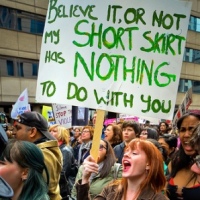I’ve just read a piece in The Conversation titled: Sexualised girls are seen as less intelligent and less worthy of help than their peers.
Who defines what constitutes sexualisation, and using what criteria?
Examples from the article: Highly sexualised clothing (a short dress and a leopard print cardigan) or a girl in a black bikini.
To the authors of this article a short dress combined with a leopard print cardigan is a signifier of a sexually easy female, and thus highly inappropriate when worn by a young girl.
I would not view any young girl wearing these garments (or any other garments for that matter) as a sexualised object. Would you?
If your answer is yes I think there might be something slightly askew in your perceptions, and you might like to ask yourself not why the young girl is wearing those outfits, but why you see her as a sex object because of them.
If as a consequence of perceiving that young girl as “sexualised” you decide she is less morally worthy and of lesser intelligence, you probably should ask yourself why, in your moral universe, a “sexualised” female (young or mature) is less worthy of moral consideration and inevitably of lesser intelligence, than a female you perceive as free from sexualisation.
In other words, why do you hold those views, and where do they come from? Are they any different from the views held by, say, racists? Are they even, perhaps, a tad misogynist?
The sexualisation debate as represented in The Conversation article is warped. Research criteria are based on the assumed authority of a male-centered gaze, introjected by women, that continues to define female sexuality in terms of how much flesh we display and the manner in which we choose to display it or clothe it. This bias remains unacknowledged and unquestioned, and ought itself to be the subject of investigation.
Somewhere in our history there developed the notion that women who are open about our sexual desire and the expression of our sexuality are correspondingly brain-dead, and undeserving of moral consideration. It’s from these notions the concepts of sexualisation and objectification evolve, not from anything women do or wear.
Obviously the signifiers of objectification and sexualisation vary with fashion and culture: a modest 2016 swimsuit would have caused its wearer to be objectified as less than morally human in 1816. The point surely must be that we have not evolved beyond our need to define ourselves as moral beings against women and girls identified as less worthy, because they are pejoratively perceived as overtly sexual, sexualised or objectified.
Concepts of sexualisation and objectification are constructed concepts and as such fluid, always open to interrogation and contestation. They are not a given, and they do not come from any transcendental exteriority. Because Collective Shout or anyone else declares a garment objectifying does not make it so.
Nothing can make a child a sexualised object other than the warped perception of an adult. As we know to our cost, warped adult perceptions of children as sex objects are rampant, and to be found in our most esteemed institutions. If you choose to view children through that warped perception there is, in my opinion, something unexamined in your thinking.
The fact that some adults care less about the welfare of women and girls they consider sexualised and objectified seems to my mind a much more urgent topic for investigation than chain stores selling pole dancing kits and Playboy stationery. To draw an equivalence between female sexuality and worthiness is warped reasoning, and that so many people in our society do this is cause for serious alarm.
The problem lies not with the sexualisation or objectification of young girls and women. It lies with unexamined attitudes to female sexuality, fear of female sexuality, and the ongoing desire to control female sexuality. If you are seeing children as sexualised and objectified have a good look at your beliefs about female sexuality, because you are likely part of the problem, not of the solution.









































Recent Comments